
Baume Longines Silver Pocket Watch with Engraved Case
A silver Baume Longines pocket watch, white dial, subsidiary seconds, Roman numerals, plate movement and dial signed Baume Longines, stem wind, pull pin at 4 o'clock (missing), Swiss 935 silver, finely engraved case, cartouche with engrave intials, size…

Longines Silver & Gold Pocket Watch with Unique Dial, Working
Longines silver & gold open faced pocket watch decorative case, with unusual dial. Case marked 800 & Longines Grand Prix Paris 1900. Case 48 mm diameter. Working when tested.

Longines Rolled Gold Pocket Watch Swiss Made, Engraved 1910
Good Longines rolled gold pocket watch Swiss made, for F W Fairchild & Sons timed in 5 positions. Movement marked Longines, made in Switzerland. Back plate engraved mother to Rollins, 1910. Working when tested. Case 48 mm diameter.
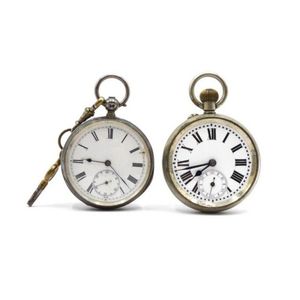
Victorian Baume Longines Silver Fob Watch and Group Collection
Victorian Baume Longines silver fob watch and group approx: Baume Longines: marked sterling silver London 1885 Ab. Key wind movement Baume Longines (running when tested) case width 47 mm. A/f to the enamel dial. Moeris patent stem wind watch Swiss…
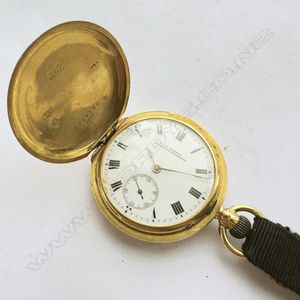
18ct Gold Baume Longines Small Hunter Pocket Watch with Monogram
Lady's 18ct gold small hunter pocket watch by Baume, Longines, plain case monogrammed to front, gold cuvette. With white enamel dial, Roman numerals, rail track minutes, subs seconds dial at VI. Stem wind movement with lever escapement. Total weight 40g.…
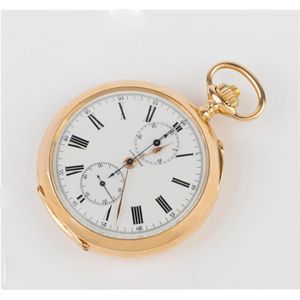
1920 Longines Gold Chronograph Pocket Watch, 14ct Gold Case
A Longines gold chronograph pocket watch, circa 1920, crown wind pin set, white enamel dial with constant seconds 30 minute register, signed case dial movement, fully jewelled Swiss lever movement, 14ct gold case, 54 mm diameter
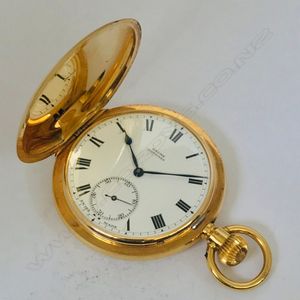
Baume & Longines 18ct Gold Pocket Watch, 18 Jewels
18ct gold hunter cased pocket watch signed 'Baume, Longines', 51 mm case in fine condition, case, internal 18ct gold cover and the movement numbered 3254557. White enamel dial, Roman numerals, railtrack minutes, subs seconds. 18 jewels lever movement…

Baume Split Seconds Chronograph Pocket Watch, 18ct Gold
18ct gold hunter cased split seconds chronograph pocket watch, by Baume (Longines) 52 mm case and gold dust cover with English import assay marks for 1907, maker's mark B&Co. Dust cover with Gisborne Racing Club presentation inscription, monogram to front…
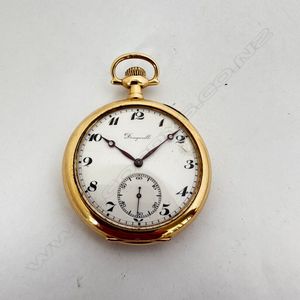
Dingwall 14ct Gold Pocket Watch with Longines Movement
14ct gold open face pocket watch retailed by D. R. Dingwall Ltd. Winnipeg, Canada. Possibly a Longines movement. 46 mm plain case, c.1920, marked for the American Watch Case Co., Toronto. with internal 14ct gold dust cover. High grade Swiss movement with…
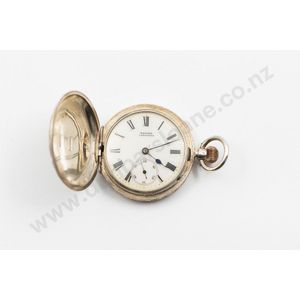
Baume Longines Hunter Case Pocket Watch with Fancy Fob Chain
.925 silver Baume Longines hunter case lever wind small pocket watch, white enamel dial with Roman numerals and seconds dial all fancy engraved covers attached on fancy fob chain with revolver charm fob

Longines 18ct Hunter Case Pocket Watch with Seconds Movement
Baume Longines 18ct small hunter cased lever wind pocket watch, Roman numerals with seconds movement
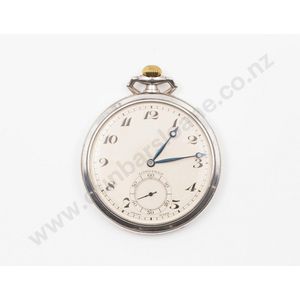
Slimline Longines Silver Pocket Watch with Arabic Numerals
Longines .925 silver open face lever wind pocket watch slimline with plain dial Arabic numerals and seconds movement

Longines 9ct Hunter Cased Pocket Watch with Engraved Covers
Baume Longines 9ct hunter cased lever wind pocket watch white enamel dial with seconds movement all machine engraved covers
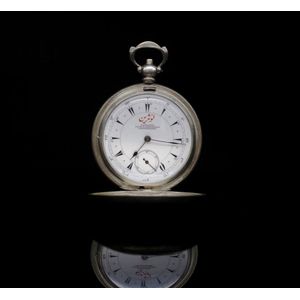
Antique Longines Sterling Silver Fob Watch, Constantinople 1925
Longines Constantinople sterling silver fob watch Ref 19.57. #44280**. Circa 1925. Nacib K. Djezvedjian & Sons, Constantinople. 7 Grand Prix. Marked swith Swiss silver marks. Approx case width 50 mm, key wind mechanism working when tested. Wear to the case

Vintage Ladies Longines Watch and Group
Ladies vintage Longines watch and group includes: Longines manual wind watch, working when tested gold plated case Ref: 300 8090. With pouch, gouges to the case. Michel Herberlin ladies quartz watch, not running. Ladies Waltham cocktail watch Circa1960s…

Silver Pocket Watch for Aurora Relief Expedition Chief Officer
A silver presentation pocket watch given to C. P. De La Motte, chief officer, Aurora relief Expedition, 1916, the Longines sterling silver pocket watch with engine turned decoration, engraved to the inner case 'Clarence Peterson de la Motte for his part…
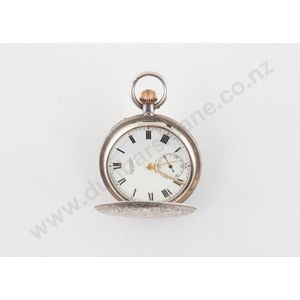
Foliate Engraved Sterling Silver Pocket Watch by Longines
Baume Longines sterling silver hunter case lever wind small pocket watch white dial with Roman numerals, all foliate engraved covers for F Jenness, lower Hutt
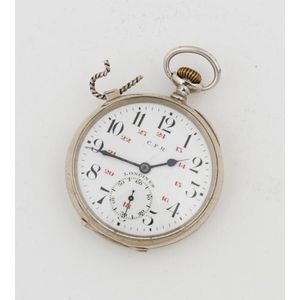
Longines Railway Pocket Watch, 1900
A Longines Cfr railway open faced pocket watch, circa 1900, nickel plated case, 15 jewel movement, enamel dial with Arabic numerals, 24-hour markings, plain blue steel hands, 51 mm diameter

Vintage Ladies Longines Watch, Manual Wind, Running
Ladies Longines vintage watch with a manual wind movement running when tested. Ref 17961011-11512201. approx case width 22 mm

Assorted Watch Cases: Certina, Longines, Cyra, Tudor, and More
Ten watch cases, no bands, including Certina, Longines, Cyra, Tudor...

Longines Gold and Enamel Pocket Watch with Napoleon Miniature
Longines, A 14ct Gold and Enamel Pocket Watch, Circa 1920. Dial: gilt with Arabic numerals, subsidiary seconds. Movement: lever movement, 17 jewels, crown wind. Case: 14ct gold circular case, polychrome enamel miniature of Napoleon signed Lrd on outer…

Longines Regulateur Half Skeleton Mechanical Wristwatch
Gents dress wrist watch Longines Regulateur Marriage half skeleton mechanical, 48 mm black dial with Roman numerals and two subsidiary dials, the open back showing fancy pierced plate pocket watch movement C1900

Longines 14k Gold Mechanical Watch, 1952
Longines 14ct yellow gold watch with a mechanical wind movement 22L, 17 jewels 85017**, marked Longines 14k to the case. Approx case width 32. No mark to crown, working when tested C.1952

Antique Longines Aviator Watch - Needs Service
Antique Longines 'aviator' watch marked Longines Avance retard to the mechanical wind mechanism 16162**. Approx case width 42 mm. Needs a service
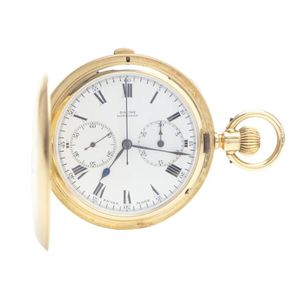
Longines Gold Chronograph Hunter Pocket Watch, 1920
A gold chronograph hunter pocket watch by Longines, crown wind and lever set, circular white enamel dial with black Roman numerals, subsidiary seconds at three and nine, signed case, dial and movement, 18ct gold monogrammed case, diameter 52 mm, retailed…

Engraved Longines Pocket Watch from Mt. Lofty SA
Vintage Longines pocket watch with engraving at the back 'reg. A. Probyn, Mt. Lofty SA'

Platinum Diamond Ruby Pocket Watch by Longines (1915)
Platinum, diamond and ruby pocket watch, Longines, circa 1915, the platinum case with transparent back, inner platinum frame set with round diamonds and French-cut rubies measuring 41 mm in diameter, the silver dial with Roman numerals and blue spade…
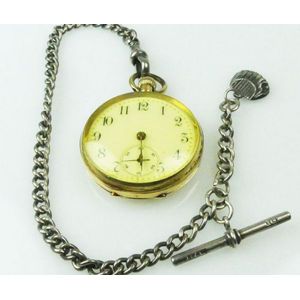
Longines Pocket Watch with Gold Case and Engraving
A small Longines pocket watch, with an 18ct yellow gold outer case, cream dial. Inner case engraved with Longines lever made expressly for 'P.A. Collot' of Durham. In good condition and working order. With silver fob curb link chain

Longines Gold Pocket Watch with Blue Enamel Bezel
A quality gold Longines pocket watch with slide pencil, 18ct yellow gold, marked to case, dial and movement Longines, circa 1920's, case ref no 4069085, movement marked 4069085, 16 jewel manual movement, with slender round case, finely detailed to bezel…

Baume Longines 18ct Hunter Case Pocket Watch
18ct hunter case lever wind small pocket watch, Baume Longines, floral engraved gilt dial

Longines 14ct Gold Full Hunter Pocket Watch & Fob Chain
Longines 14ct gold cased full hunter pocket watch with two tone Albert fob chain, circa 1900, 5 cm diameter, chain weight 12.5 grams

9ct Rose Gold Longines Ladies Pocket Watch - 19.2g
A 9ct rose gold Longines ladies pocket watch, 19.2g
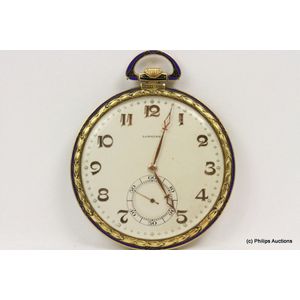
Longines Gold Pocket Watch with Enamel Detail and Pencil
A quality gold Longines pocket watch with slide pencil, 18ct yellow gold, marked to case, dial and movement Longines, circa 1920's, case ref no 4069085, movement marked 4069085, 16 jewel manual movement, with, slender round case, finely detailed to bezel…

18ct Gold Longines Pocket Watch with Original Box
A gold slim cased gold Longines pocket watch, 18ct yellow gold, case no 3626444, crown wind signed movement, no 3626444, with engine turned case, white enamel dial, black oversized Roman numerals, two hands, sub dial, fitted in original box.

Longines Carnegie Commemorative Pocket Watch in Sterling Silver
Longines 'Andreas Carnegie' sterling silver open faced commemorative pocket watch, circa 1911. Original embossed leather box. 5 cm diameter

Longines Gold and Diamond Pocket Watch
Longines, gold and diamond hunter case pocket watch, lever movement, fully jewelled, 18ct gold case chased and engraved with scrolling leaves and set with diamonds, white enamel dial with Roman numerals, outer Arabic minute track and subsidiary seconds…

Antique Longines Swiss Pocket Watch, 18ct Gold, Working
18ct yellow gold Longines Swiss made pocket watch chronograph c.1890's, in working condition with enamelled face, marked Baume Longines approx. 104.1gr
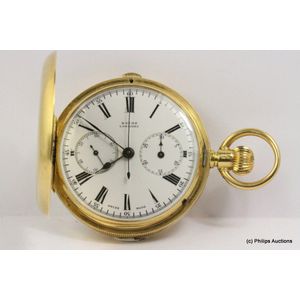
18ct Gold Baume Longines Pocket Chronograph Watch
A gold full hunter chronograph pocket by Baume Longines, 18ct yellow gold. Swiss case with London import mark 18ct 2222905. B& Company 1909, movement Baume Longines all Swiss chronograph. crown wind, total weight: 104.2 grams

Antique Longines Gold Watch, Circa 1900
Longines. A 14ct gold hunting cased watch no 1306131 circa 1900, gilt lever movement, fully jewelled, white enamel dial, black painted Arabic numerals, fancy gilt hands, subsidiary seconds, outer minute track, monogrammed polished case, case, dial and…

Art Nouveau Longines Pocket Watch with Diamonds
A Longines gold and diamond pocket watch crown wind, circular white dial with Roman numerals, signed case, dial and movement, 18ct gold, diamond set Art Nouveau designed case, 30 mm diameter

Longines Silver Hunter Cased Pocket Watch with Seconds Movement
Baume Longines.935 silver hunter cased lever wind pocket watch with seconds movement

Baume Longines Pocket Watch 1884 Silver and Gold Dial
Sterling silver open face key wind pocket watch fancy silver and gold dial with seconds movement by Baume Longines London 1884
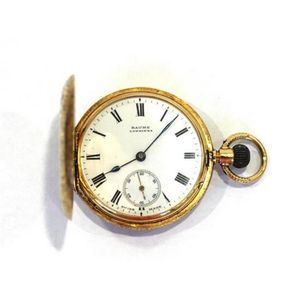
18ct Baume Longines Pocket Watch with Filigree Engraved Case
An 18ct yellow gold Baume Longines pocket watch, white dial, black Roman numerals, blue hands with a second subsidiary dial, engine and filigree engraved 18ct yellow gold case. Case stamped B & Co., movement stamped Baume Longines

Tiffany & Co Seed Pearl Pendant Watch with Diamonds
Tiffany & Co an 18ct gold, seed pearl, enamel and diamond-set openfaced keyless pendant watch made for Tiffany & Co by the Longines watch Company mvt 2349159 case by Wittnauer & Co no 1067 circa 1915, manual winding movement, 17 jewels, gilt dial, Arabic…

Longines Gold Pocket Stopwatch, 14ct, Enamel Dial
A gentleman's gold openface pocket stopwatch, Longines. 52 mm. Crown wind. Case, dial and movement signed. White enamel dial, black Roman numerals, subsidiary seconds and 30 minutes recorder. Plain polished case. 14ct yellow gold. Total weight 110.85…

14ct Gold Longines Pocket Watch with Enamel Dial
Lady's 14ct gold Longines open face pocket watch, white enamel dial with Arabic numerals, subsidiary seconds, stem wind and set on a 15 jewel plate movement no. 1300239, signed Longines, momogrammed rear cover. Size 29 mm.

Longines Rolled Gold Full Hunter Pocket Watch
A Longines rolled gold full hunter pocket watch, white enamel dial, Arabic numerals, subsidiary seconds on a stem wind, push piece at 4 o'clock on a plate movement in a guilloche case with vacant cartouche. Size 50 mm. C 1919. Front cover slightly off…

Baume Longines 18ct Gold Pocket Watch with Roman Numerals
An 18ct gold ladys pocket watch, white dial and movement signed Baume Longines, with Roman Numerals, subsidiary seconds dial, push piece at 11 o'clock on a lever movement, engraved case with vacant cartouche, working, missing glass. Wt. 28.2g
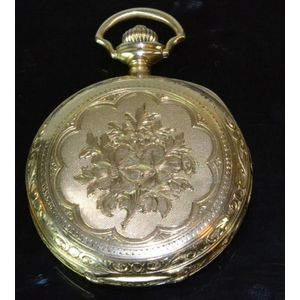
Antique Edward Prior Longines Pocket Watch in 18ct Gold
A rare 18ct yellow gold Longines ottoman Empire, Edward Prior pocket watch, c.1900, top wind movement, dial and verso movement marked 'Edward Prior, London

1965 Longines 9ct Yellow Gold Gents Watch by Baume
Longines gents watch 9ct yellow gold case hallmarked London 1965, marked BAUME ( Longines agent in London)

Antique Ottoman Longines Pocket Watch with Key
Antique Longines silver pocket watch with key retailed by ottoman Empire Jewellers Nacib K Djezvedjian Son Constantinople. In working order. Approx 5 cm diameter

Antique Longines Swiss Pocket Watch, 14ct Gold, 1920s
A keyless Longines & Co. Swiss hunter pocket watch, c.1920, stamped 14ct gold Wadsworth case with 19 jewel lever movement, bi-metallic balance. Enamel dial in good condition. N.2775369. Diameter 45 mm. Weight 65.4gms.

Longines Pocket Watch: Presentation to C.P. de La Motte (1916)
A presentation pocket watch to C.P de La Motte ' 1916 Chief officer Aurora' relief Expedition 1916, the Longines pocketwatch in sterling silver, with engine turned outer case, the inner case with presentation engraving to 'Clarence Peterson de la Motte…

Tiffany's 18ct Gold Seed Pearl Pendant Watch with Diamonds
Tiffany & Co., an 18ct gold seed pearl enamel and diamond-set openfaced keyless pendant watch made for Tiffany & Co. by the Longines Watch, company mvt 2349159 case by Wittnauer & Co no 1067 circa 1915 Nickel lever movement, 17 jewels, gilt dial, Arabic…

Antique Longines Gold Hunting Chronograph Watch, 1900
A Longines 14ct gold hunting cased chronograph watch case 1319768 Swiss circa 1900 Lever movement, white enamel dial, Arabic numerals, scroll hands, two subsidiary dials indicating constant seconds and register for 30 minutes, outer ring calibrated for…

Longines Enamel and Diamond Pocket Watch with Polychrome Design
A lady's enamel and diamond-set pocket watch, by Longines, late 19th century, the polychrome enamel cover depicting a putto rowing a boat preceded by two swans and a bird, accented by rose-cut diamond foliate decoration, to the reverse engraved with the…

Longines 1984 Olympic Pocket Watch with Diamond Emblem
Longines 1984 Olympic Pocket Watch, case 14ct yellow gold with 104 full cut diamonds forming the USA Olympic emblem on the front cover, brushed outer edge with text 'Games of the XXIII Olympiad Los Angeles 1984'; dial silver with diamond dust like finish.…

Kristfeld Longines Silver Pocket Watch
A silver open-face pocket watch, the dial marked for Kristfeld, Nurnberg, the case and Swiss movement marked Longines

Baume Longines 18ct Open Face Fob Watch
18ct open face fob watch by Baume Longines, fancy gilt dial and engraved back cover, lever wind

Longines Open-Face Pocket Watch with Presentation Inscription
Cased 14ct open face pocket watch no 5173701 by Longines, gilt dial with seconds movement, lever wind with presentation inscription dated 1916-1941 on 14ct fine curb link chain complete with glass dome stand

Longines 9ct Gold Pocket Watch with Roman Numerals
Longines 9ct gold open face pocket watch; white dial, Roman numerals, subsidiary seconds dial on a stem wind and set 15 jewel movement. Movement and dial signed Baume Longines No. 3893485. Wt. 62.3g

Longines 9ct Gold Pocket Watch with Roman Numerals
Longines 9ct gold open face pocket watch; white dial, Roman numerals, subsidiary seconds dial on a stem wind and a set 15 jewel movement. Movement and dial signed Baume Longines No. 3893485. Weight 62.3gm
 Loading more...
Loading more...